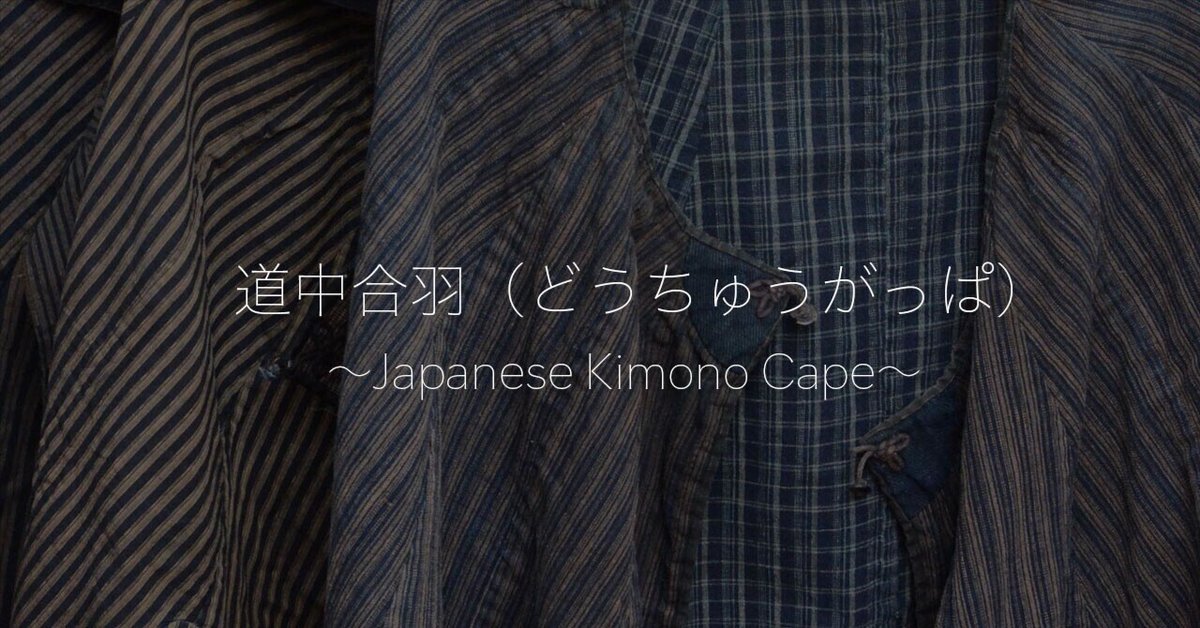
道中合羽(どうちゅうがっぱ) | Japanese Kimono Cape
ご訪問いただきありがとうございます。
誰も知らないけど奥深いジャパンヴィンテージの世界、野良着以外にもかっこよくて、面白いアイテムがあります。
今回はそんな中でもとりわけ、目立ち、服好きの方も唸る、道中合羽(どうちゅうがっぱ)をご紹介させていただきます。
Thank you for visiting us.
No one knows about the deep world of Japanese vintage, but there are cool and interesting items besides noragi.
This time, we would like to introduce Docyu Gappa (Kappa) / Japanese Kimono Cape, which stands out and attracts fashion lovers.
道中合羽とは? | What is Japanese Kimono Cape?

16世紀頃、日本へ来航したスペイン人やポルトガル人が着用していた外套が起源とされる、道中合羽(どうちゅうがっぱ / どうちゅうかっぱ)。
江戸時代中期頃になると、木綿を使用した合羽が作られ始め、主に雨風を防ぐアウターとして着用されたそうです。
股旅や歌川広重の東海道五十三次にもありますが、トラベルウェアとしても着用されていた事から、名称に道中がついたようです。
It will be a Japanese vintage Dochu Kappa from the Meiji to Taisho eras.
Dochu Kappa is said to have originated from the items worn by the Spanish and Portuguese who came to Japan around the 16th century.
Around the middle of the Edo period, kappa using cotton began to be made, and it is said that it was mainly worn as an outerwear to protect against rain and wind.
It is also seen in Matatabi and Hiroshige Utagawa's Fifty-three Stations of the Tokaido, but it seems that the name dochu was added because it was also worn as travel wear.
道中合羽の特徴 | Features of Japanese Kimono Cape

海外由来の外套が起源であることから、デザインとしては袖が無く、肩に掛けて羽織るということが最大の特徴だと思います。
海外のケープと着方や全体のデザインに関しては大差がございません。
しかし、最も異なる点は、ディテールに尽きます。
Since it originated as a cloak from overseas, I think the biggest feature is that it has no sleeves and is worn over the shoulder.
There is no big difference in terms of how to wear and overall design from overseas capes.
But the biggest difference comes down to the details.

海外のケープは、フロントにボタンが複数付き、留める場合が殆どです。
しかし、道中合羽はと言うと、主に首周りに1〜2つの留め具で止める場合が多いです。
Overseas capes often have multiple buttons on the front and are fastened.
However, when it comes to Japanese kimono cape, it is mostly fastened with one or two fasteners around the neck.

こちらの個体は違うのですが、生地に防水性を高めるために油を染み込ませた油紙が入っていることもあり、どこか日本的な創意工夫を感じさせます。
こちらの個体は違うのですが、生地に防水性を高めるために油を染み込ませた油紙が入っていることもあり、どこか日本的な創意工夫を感じさせます。
This individual is different, but the fabric contains oiled paper that is soaked with oil to improve waterproofness, and it gives you a sense of Japanese ingenuity.

剥離を防止するためステッチが入っております。
このステッチもデザインされており、海外の質実剛健な物作りとは少し異なる、アート性を感じさせます。
Stitches are included to prevent peeling.
This stitch is also designed, and it makes you feel artistic, which is a little different from the simple and strong overseas manufacturing.
ファッションとして優秀&最高の佇まい | Excellent fashion & best appearance

古いアイテムですが、コスプレっぽくならず、道中合羽はめちゃめちゃかっこいいです。
デザイナーズブランドやモード系のスタイリングお好きな方にもマストなアイテムだと思います。
シンプルなアイテムとの相性が非常に良いので、いつものスタイリングに合わせても素敵です。
It's an old item, but it doesn't look like cosplay, and the Japanese kimono cape is super cool.
I think it's a must-have item for those who like designer brands and mode style styling.
It goes very well with simple items, so it's nice to match it with your usual styling.
道中合羽が欲しくなった方は | If you want Japanese kimono cape

今回の道中合羽の記事は如何だったでしょうか。
古着屋に行こうが、どこに行こうが、そうそう簡単には出会うことのできないアイテムです。
当方の道中合羽も、その7〜8割ほどは海外に旅立っていきます。
古い物との出会いは奇跡的ですので、是非、下記のリンクからご確認くださいませ。
ご覧いただきありがとうございました。
How was the article on Japanese kimono cape this time?
Whether you go to a second-hand clothing store or wherever you go, it's an item that you can't easily find.
About 70% to 80% of our Japanese kimono cape will go abroad.
The encounter with old things is miraculous, so please check it out from the link below.
Thank you for watching.


この記事が参加している募集
この記事が気に入ったらサポートをしてみませんか?
